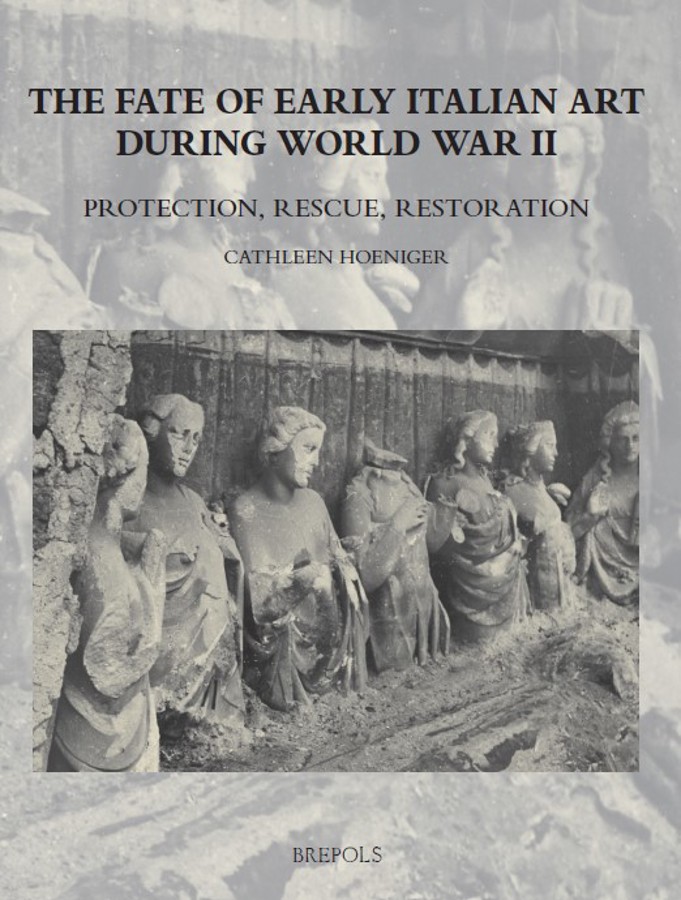
- Pages: 429 p.
- Size:216 x 280 mm
- Illustrations:59 b/w, 42 col., 1 maps b/w
- Language(s):English
- Publication Year:2024
- € 95,00 EXCL. VAT RETAIL PRICE
- ISBN: 978-2-503-60974-4
- Hardback
- Available
This book charts the plight of frescoes and other immovable art in Italy’s early churches during World War Two, examining how the Italian heritage offices struggled to protect, rescue, and restore late medieval and early Renaissance works of art amidst a shifting political landscape of Fascism, German Occupation, and the arrival of the Allied Army.
Cathleen Hoeniger holds a PhD from Princeton University and is a Professor of Art History at Queen’s University, Canada. A specialist in Italian Medieval and Renaissance painting, and the history of art restoration in Italy, Cathleen also actively teaches and publishes on cultural heritage preservation, particularly the impact of war on art and architecture. She is the author of two previous books, one on early Italian painting in Tuscany and the other on Raphael.
Geoffrey Hodgetts is Professor Emeritus of Family Medicine at Queen’s University, Canada. In addition to medical practice and teaching, Geoffrey led a long-term project in Bosnia-Herzegovina to rehabilitate healthcare after the Balkans Conflict, and later was the public health advisor to NATO command in Afghanistan. He has taught and published on the impact of conflict on the health of societies.
In Italy, art historians can study wall-paintings, tombs, and stained-glass windows in the early churches for which they were created because they have been preserved in situ over the centuries. This book explores one fraught period of this critical preservation work, during the five years of World War II in Italy, when numerous artistic monuments of value were vulnerable to damage and destruction. Works of art from the late Middle Ages and Early Renaissance lie at the focus, among them, the Angevin tombs of Santa Chiara in Naples, the frescoes of Pisa’s Camposanto, Piero della Francesca’s wall-painting of Sigismondo in the Tempio Malatestiano in Rimini, and the Mazzatosta Chapel in Viterbo. Rooted in the archives, the narrative charts the formidable task of safeguarding stationary art in the midst of aerial and ground attacks. Taking centre stage are the struggles endured by heritage superintendents, the innovations tested under pressure by art restorers, and the desperate position of clerical custodians of churches. The Allied Monuments Officers, who arrived over halfway through the war, provided substantial assistance in the rescue of damaged art from ruined buildings. This study offers an original perspective by emphasizing the Italian protagonists, whose efforts played out against the political and economic landscape of fascism and the devastation wrought by the war on Italian soil.
Chapter 1. Introduction
Chapter 2. Historical Background: Italy’s Experience of World War II – Geoffrey Hodgetts
Chapter 3. The Role of the Italian Federal Government in the Protection of Monuments from War Damage
Chapter 4. The Defence of Art in the Italian Provinces before and during World War II
Chapter 5. The First Responses to the War Damage of Early Italian Art, 1943-1945
Chapter 6. What Befell the Mazzatosta Chapel in Viterbo and the Wider Circumstances in Lazio Province during World War II
Chapter 7. The Wall Paintings of Pisa’s Camposanto Monumentale in the Context of World War II
Chapter 8. Conclusion
Bibliography
Index




